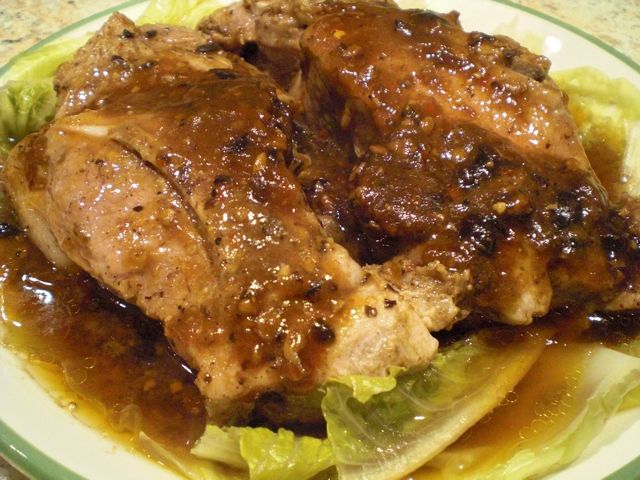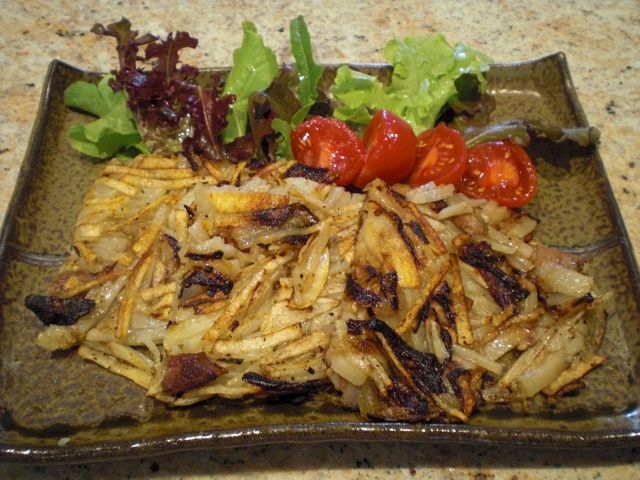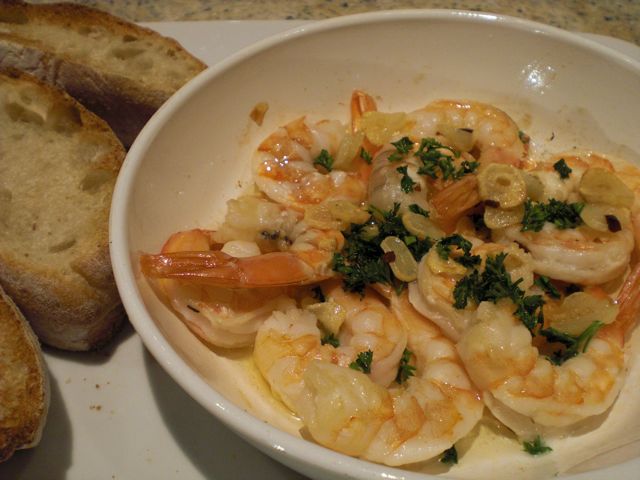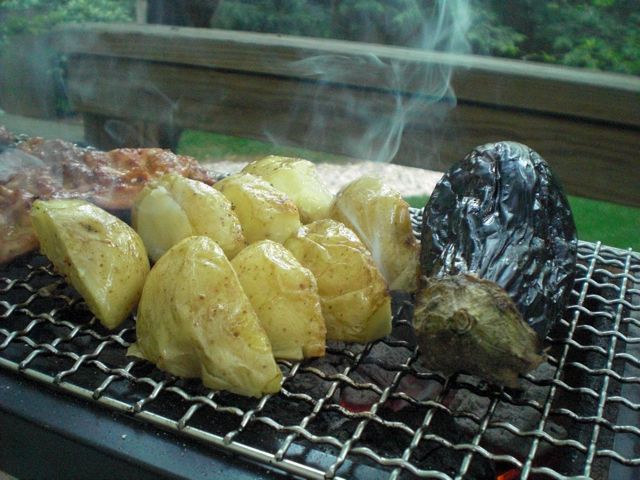Thursday, August 19, 2010
Steamed pork spareribs with black bean garlic sauce 豚骨付きバラ肉の豆鼓蒸し
This is derived from a Cantonese dish called 豉汁蒸排骨 "si zap zing paai gwat". I should have used "rib tips" to be authentic (which apparently can be had in a Chinese butcher/grocery store) but I used the entire spare rib which has significant belly portions attached and much more meat than the traditional "rib tips".

I used two bone-in pork spare ribs (about 400-500 grams or about 1 lb.). The marinade is made of black bean garlic sauce 蒜蓉豆鼓醤 (2 tbs), chili garlic sauce 蒜蓉辣椒醬 (1 tsp), soy sauce (1 tbs), sake (2 tbs), roasted sesame oil (2 tsp), sugar (1 tsp), potato or corn starch (2-3 tsp) and grated ginger (1/2 tsp). I did not add more garlic or red pepper since both sauces contain garlic and the chili garlic sauce is quite spicy (but you could add these). I first season the meat with a sprinkle of salt and black pepper (go light, the sauce has enough salt) and massage in the marinade and let it sit for 30 minutes at room temperature. I then set up a steamer (I use an electric wok). I place several leaves of cabbage and lettuce on the bottom of a large deep plate (I used a pasta plate) and set it in the steamer with strong continuous steam. Since the size of meat is much larger than "rib tips", I steamed for about 1 hour. Because of the potato starch, a nice sauce will form on the bottom of the plate.

I cut a small portion and serve it with steamed cabbage and lettuce. Although the meat has nice flavors, it is a bit tough. I put the left-overs in the refrigerator. A few days later, after removing the congealed fat, I re-steamed it for another 20-30 minutes with a base of fresh lettuce leaves. The meat became much more tender and the flavor better amalgamated. I served this dish as a small drinking dish but you could serve a larger portion over cooked rice with more sauce, that will be a dinner.
Tuesday, August 17, 2010
German Potato Hash ジャーマンポテトハッシュ
Japanese Izakaya version of so-called "German potato" appears to be rather fatty and they often (not always) use commercial frozen french fries. Onion is cooked with bacon and then combined (Mark's book p24). Instead of the Japanese variation or a classic German potatoes, I make a hybrid between Potato hash and German potatoes. This is perfect for breakfast as well as a snack with a drink. My version is less fatty but not bad (albeit not photogenic either).

 Now, keep frying for another 5 minutes, so that the other side becomes brown and crispy. I cut this into 4 quarters and serve. You could serve this with a side of ketchup. For breakfast, serve this with fried egg(s). You could, of course, use real bacon and bacon grease to fry the onion and potato which will make this dish definitely better. But for a lower-fat alternative, this is not bad at all.
Now, keep frying for another 5 minutes, so that the other side becomes brown and crispy. I cut this into 4 quarters and serve. You could serve this with a side of ketchup. For breakfast, serve this with fried egg(s). You could, of course, use real bacon and bacon grease to fry the onion and potato which will make this dish definitely better. But for a lower-fat alternative, this is not bad at all.
This will make a generous (for us at least) serving for two. Instead of bacon, I use roasted pork tender loin seasoned with rosemary, which we cook often. We use the leftovers for sandwiches and other dishes such as this one. I cut small strips of roasted pork tenderloin (about 2 inches long) and fry it with a small amount of olive oil (1 tbs) until the edges get crispy and start to smell a bit like bacon (it's the same animal after all). I add onion, halved and sliced into thin strips (one small) and saute until soft and slightly browned. I season it with salt and pepper. I set these cooked items aside on a plate.
Meanwhile, I thinly slice and julienne white potatoes (2 medium) and add olive oil (1 tbs) in the same frying pan and saute until all the potato pieces are coated with oil and add the mixture of the pork and onion back into the potatoes. I season again with salt and pepper. After sauteing for 1-2 minutes, I flatten the mixture into a thin disk using a silicon spatula (just in case you have not noticed, I love silicon spatulas) (left images below). I turned down the flame to low and put on a tight fitting lid so that the bottom browns and the rest of the potatoes steam. I cook it like this for 10 minutes. Shake the pan to make sure the entire disk of hash moves as a single unit (meaning the bottom is not sticking and all the potato pieces are sort of melded together because of the starch.) If any portion is sticking, use the spatula to encourage the potato to unstick from the bottom of the pan and flip (right image below). (The flipping part requires some skill to make it all return to the pan as desired. That is one reason you make sure that the pieces are melded together)
Sunday, August 15, 2010
Small squid stuffed with crab meat イカのカニ肉詰め
I used the body of rather small squid. The stuffing is lump crab meat (not canned), minced shallot, minced fresh tarragon (from our garden) and basil. I seasoned it with salt and pepper. The proportions are sort of arbitrary as I made it. Stuff 2/3 of the squid body with the crab meat stuffing and close it with a tooth pick. I sauteed it in a frying pan with a bit of olive oil for 3 minutes on each side and added a small pat of butter and then put the frying pan in a 450F oven for 3 minutes to complete the cooking. Since there was stuffing left, I added a bit of mayonnaise and Dijon mustard and made small crab cakes as well.
Friday, August 13, 2010
Store bought sushi from a near-by market アメリカ市販のお寿司
This post is to remind those people privileged enough to have easy access to quality sushi and bento boxes, particularly in Japan, how good they have it. In the past 10 years or so, increasing numbers of gourmet markets in the U.S. as well as even regular supermarkets started carrying sushi. In many food courts like the one in Union station, you can find small sushi bars mainly for take-out. Some gourmet markets even have a small sushi bar in the store. Some cafeterias may even offer a box of sushi (mostly rolls). The quality of the sushi served in these places, however, often leaves much to be desired. If we like to have take-out sushi for a party, our best bet is to place a take-out order in our favorite sushi bar for pick up just before the party.
This one was bought from the near-by gourmet market. It is made on the premises, but not to order, the plastic sushi boxes are placed in the cold case. So, sometimes these sushi boxes may be sitting in the cold case for quite some time. I served the sushi on a plate with my asazuke and real wasabi to make it more presentable. I also made a tofu and nameko (small slimy Japanese mushroom) miso soup with a garnish of chopped scallion and myouga.
While the fish, luckily was fairly fresh if somewhat spongy, in general the quality of the sushi was dismal. As you can see in the picture the California roll barely held together. The rice balls were huge (in the U.S. big is better) and unless we practically choked ourselves stuffing them into our mouth in one bite they quickly fell apart while trying for a more manageable two bites. The rice was especially disappointing. It turned out to be dry and hard without much vinegar flavor. Although sushi means vinegared rice for some reason much of the sushi sold this way seems to leave it out--(saving costs? Americans won't notice?) So why did we even bother buying this stuff? It's better than nothing when you need a sushi fix for lunch. Desperate times call for desperate measures (Due to recent demands at work and other factors we did not have a chance to visit our sushi bar much this summer). At least, the miso soup was excellent (because I made it). We have to hit the sushi bar soon!!
Wednesday, August 11, 2010
Gambas al Ajillo 海老のニンニクオリーブオイル焼き
This is a quintessential tapas dish. As far as I am concerned, any good tapas dish can be a good Izakaya food. Many years ago, our Spanish friend served this to us at a small party held in his backyard. Since then, this "gambas" became our favorite and quick snack accompanying a drink. I think the way I make this dish is based on the recipe in my old tapas cook book with my slight modification (of course).

Shrimp: For this dish, relatively small shrimp (20-25 count/lb) works best. Since the vast majority of shrimp we buy here are previously frozen and thawed at the store (they say "for your convenience" but sometimes they are sitting in a case for several days after thawing), I rather buy frozen raw shrimp and thaw it myself. For quick thawing, I use running tap water. Some say the flavour will be lost in the running water but it is quick and convenient for me. Sprinkling salt on the shrimp after thawing appears to bring back some briny flavours of the ocean. This one is peeled and deveined except for the tail segment. I dry them on a paper towel.
I use a small flat Pyrex pan as seen above but any small flat pan will also work. I add 3-4 tbs of good quality olive oil (olive oil is an important part of the dish and we dip the bread to soak it all up). I thinly slice garlic (2-3 fat cloves) rather than finely mincing it. I slowly fry the garlic pieces on a low flame with red pepper flakes (whatever amount you like) until they are fragrant and the garlic slices are slightly browned. "Slowly" is important since the garlic flavour is transferred to the oil better and the garlic slices become crispy (become garlic chips) without imparting a burnt bitter taste. Take the garlic chips out of the pan and put them on a small paper towel lined plate and set aside. I then fry the shrimp in the garlic scented olive oil for 30 seconds on each side or until just done and take it off the heat. I sprinkle chopped parsley, lemon juice on the cooked shrimp and garnish with the garlic chips. You could sprinkle Spanish paprika if you wish (mostly for decoration). I do not add any salt since it was already added after the shrimp thawed.
For this, we need a rustic and crusty bread like good baguette or ciabatta. We happened to have a very nice crusty ciabatta from a local bakery. We opened the last bottle of Vilafonte. It went with the meal very well.
Shrimp: For this dish, relatively small shrimp (20-25 count/lb) works best. Since the vast majority of shrimp we buy here are previously frozen and thawed at the store (they say "for your convenience" but sometimes they are sitting in a case for several days after thawing), I rather buy frozen raw shrimp and thaw it myself. For quick thawing, I use running tap water. Some say the flavour will be lost in the running water but it is quick and convenient for me. Sprinkling salt on the shrimp after thawing appears to bring back some briny flavours of the ocean. This one is peeled and deveined except for the tail segment. I dry them on a paper towel.
I use a small flat Pyrex pan as seen above but any small flat pan will also work. I add 3-4 tbs of good quality olive oil (olive oil is an important part of the dish and we dip the bread to soak it all up). I thinly slice garlic (2-3 fat cloves) rather than finely mincing it. I slowly fry the garlic pieces on a low flame with red pepper flakes (whatever amount you like) until they are fragrant and the garlic slices are slightly browned. "Slowly" is important since the garlic flavour is transferred to the oil better and the garlic slices become crispy (become garlic chips) without imparting a burnt bitter taste. Take the garlic chips out of the pan and put them on a small paper towel lined plate and set aside. I then fry the shrimp in the garlic scented olive oil for 30 seconds on each side or until just done and take it off the heat. I sprinkle chopped parsley, lemon juice on the cooked shrimp and garnish with the garlic chips. You could sprinkle Spanish paprika if you wish (mostly for decoration). I do not add any salt since it was already added after the shrimp thawed.
For this, we need a rustic and crusty bread like good baguette or ciabatta. We happened to have a very nice crusty ciabatta from a local bakery. We opened the last bottle of Vilafonte. It went with the meal very well.
Monday, August 9, 2010
Grilled salmon with Ponzu soy sauce and Grated Daikon radish 焼塩鮭のポン酢みぞれ和え
I grated the daikon and squeeze out the excess liquid (about 1/4 cup) and added ponzu soy sauce (about 1 tbs from the bottle). I then crumbled the grilled salmon leftovers and mixed them into the daikon. I splashed Yuzu juice (from the bottle) on the top and garnished with finely julienned radish and finely sliced scallion (I used the green part for color). A simple quick dish but it was quite nice with cold sake. A good start.
Saturday, August 7, 2010
Grilled egg plant 焼き茄子
In Japan, you can get such nice and fresh vegetables, including cucumbers and eggplants, much more easily than in the U.S.. There are several kinds of Japanese eggplants; some can be even eaten raw ("water eggplant" or "Mizunasu" 水茄子). I like "Kamonasu" 賀茂茄子, famous for being used in Kyoto cuisines. You can not get these easily in the U.S.. The kind of eggplants we can get here are limited to mostly Western varieties. Occasionally, what they call a "Japanese" eggplant is available (a light purple and small elongated kind) but I do not recall seeing similar eggplants in Japan. I tend to use small Italian eggplant and Zebra eggplant for my Japanese style cooking but, sometimes, it does not work out. Simply grilled Japanese eggplant, "yakinasu" 焼き茄子 is wonderful if the eggplant is good. I found a small (baby) Italian eggplant which looked very good but bought only one, because the last time I tried to make this from Italian eggplants, it was pretty bad. I am sure, because I only got one this time, it turned out pretty good and I wish I had bought more.

Before grilling, I just prick the skin of the eggplant all over with the tines of a fork or a tip of a bamboo skewer to prevent from the eggplant from exploding (This happened once in our Weber grill. We heard a big "bong" noise. A small puff of ash came out the bottom vents of the grill. Upon investigation we found the meat of the eggplant spread all over the inside of the lid. Nothing was left on the grill except for few fragments of the charred skin.) After 15 minutes or so, the eggplant is thoroughly cooked (turn several times during the cooking) and soft as seen below. Make sure the eggplant is completely cooked. Using chopsticks or tongs, peel off the skin holding the cap while it is hot. Using a small knife or a bamboo skewer, cut the eggplant along the long axis (you can plant the skewer in the meat near the cap and then grab the cap and pull the skewer through). repeat this a few times to make long strands of eggplant. Cut at the cap but I keep the cap for presentation. I garnish with dried bonito flakes and chiffonade of perilla. As a seasoning, I can use just soy sauce but I happened to make my dipping sauce for other dishes we had (dashi 2 parts, mirin 1 part and soy sauce 2 parts) so I used my dipping sauce.

Eggplant is almost done along side potatoes which are being grilled for "Jagabata" or potato with butter.
Subscribe to:
Posts (Atom)


